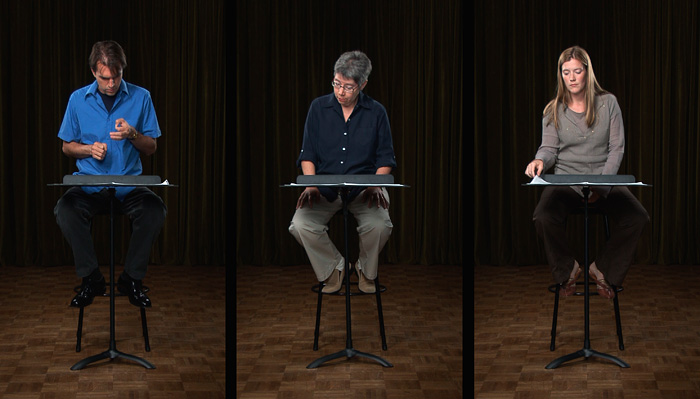Comments on Antonia Hirsch's "Tacet"
Part of the National Gallery of Canada's "It Is What It Is" Exhibit, Winter 2011


Antonia Hirsch’s video contribution to the “It Is What It Is” exhibit at the National Gallery of Canada, which ran from November 5th to April 10th, 2011, was presented in a dark, theater-like room. I sat alone on a soft bench, and watched a wall-sized projection in front of me. The projection was divided into three parts, and in each panel a nondescript adult silently looked through a bound collection of papers. As the three subjects took in visual information, I noticed their performative style of reading; they made facial expressions and gestures as they read, and in such a way that I thought this must be some kind of over-acting: an over-zealous actor’s response to a stage direction of “pretend you’re reading.”
One thought I had was that the piece might be about the act of reading itself. Another was to consider the different appearances of the three characters, and what these might mean: a young man, an older woman with a short haircut, and a young woman with long blond hair. Could the piece be somehow about gender roles, and how these relate to reading and the act of reading? I was grasping at straws. I watched it a couple of times, then walked out into the light where I read the title and wall text.
Hirsch’s piece is called “Tacet” (meaning “quietly”), which is mentioned in museum literature as recollecting instructions for John Cage’s 4’33”. And this is not just the speculation of some art writer – the association was stated by Hirsch herself, so we can assume some intentional significance there, even if it exists only as a kind of tribute or curtsey.
The conceptual “hook” amounts to a simple fact about the piece and what the actors are doing: “Tacet” shows three orchestral conductors silently sight-reading the national anthems of Canada, The United States, and Mexico. This amounts to obvious politicization, which fits into the thematic structure of the Supercanadian “It Is What It Is” exhibit.
The National Gallery’s didactic did not say which conductor was reading which national anthem, although I was tempted on my second viewing to try and guess. I couldn’t find any good information on the Internet, although one blogger writes, “From just the facial expressions of the three readers, you can tell which is which.” I think is a nonsensical stretch of his or her imagination; certainly this was not obvious to me.
This blogger might be a good case study for Hirsch’s audience and for her artistic intent – it’s possible that Hirsch wants people to want to guess which anthem is being read by which conductor, and to make assured assertions based on their own preconceptions about national character. Not knowing which conductor was reading which anthem is indeed strangely frustrating, and I think this frustration is part of the piece; the effect of “Tacet,” for me, is to obscure national identity with the silencing of the three national anthems, and my guess is that this is Hirsch’s intent. I liked the piece more after understanding this textual information about it, but what does the fact that this dramatically changes the reading of the piece say? Does it mean that the piece is incapable of standing on its own, and that it needs Antonia Hirsch next to it at all times, telling you what you’re looking at?
I feel as though I’m setting up an indictment of purely or perhaps overly conceptual work – work that needs some verbal one-liner or idea in order for the art object to function properly. This kind of work can feel too clever, too Duchampian, and, as I inferred, more like a one-liner than a piece of art. Is it enough to keep someone interested for longer than the split second it takes to get the joke?
“Tacet” is explicitly about nationalism, but it is not a great big Canadian flag, nor is it a Native, a Frenchman, and an Englishman holding hands – in fact, I’m not sure that it’s saying anything good about nationalism or national identity, Canadian or not. By silencing the national anthems it’s as though nationalism itself is being silenced, or turned into a ghost of itself, although anthems are perhaps a relatively “harmless” way to be nationalistic – at least more harmless than shooting or blowing up other countries’ citizens.
NAFTA – the North American Free Trade Agreement – amounts to an unregulated international market, something the economic restrictionist part of contemporary political leftism is not in favor of. It’s not a big secret that politics in the art world mostly turn towards the left, excepting outliers like the UK’s Gilbert and George. So, without a careful analysis of what’s going on in “Tacet” and what it symbolizes, some cultural observer might presume Hirsch is saying NAFTA is bad, if this observer sees that she’s a contemporary gallery artist, and that she mentions NAFTA in her wall text.
However, the effect of evaporating the sound from the three national anthems is to make each of these nations the same – to evaporate national differences, and to make North America a cohesive, indistinguishable unit, which NAFTA does, in an economic sense, by lifting trade restrictions, irrespective of any market tyrannies that may or may not produce inequities as a result. Maybe Hisrch is an iconoclastic fiscal conservative, just like Gilbert and George.
But maybe not. In spite of both the museum’s wall text and Hirsch’s own website’s explicit mentioning of NAFTA, it is possible that Hirsch’s project is not really about NAFTA, or trade, but simply about North American national identity (and the concept of nationalism overall), and how it is a gossamer thing. This amounts to an especially poignant comment in Canada.